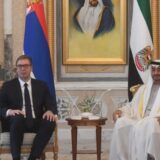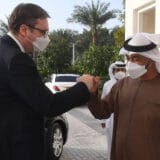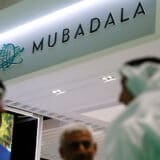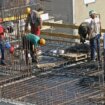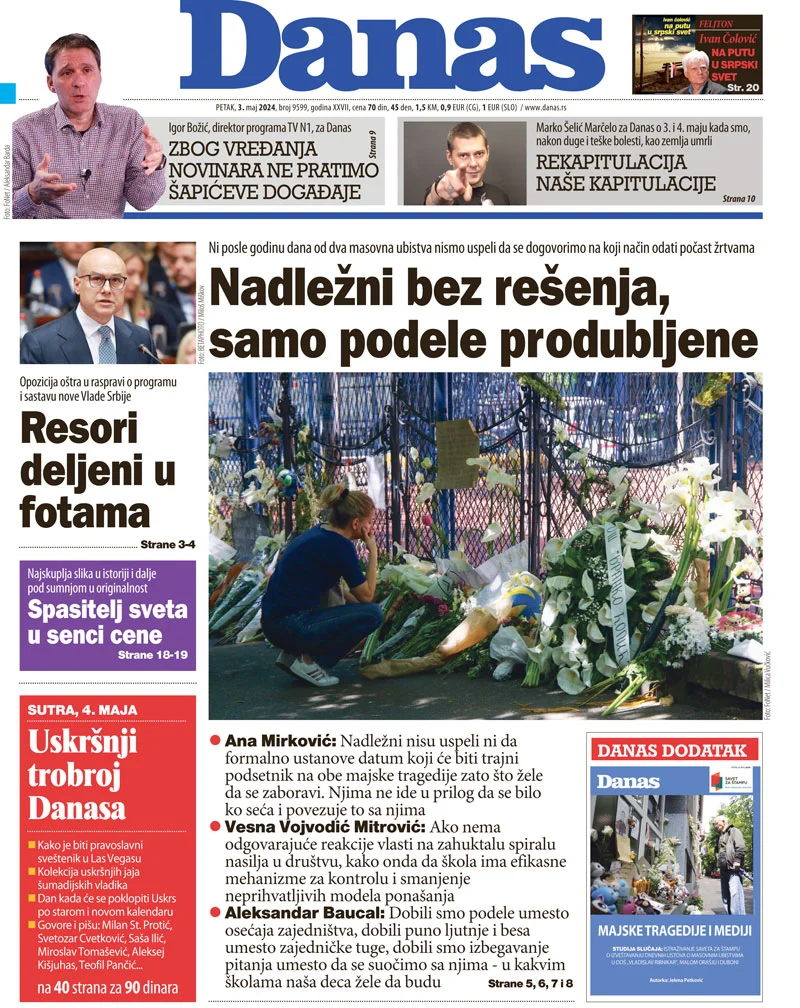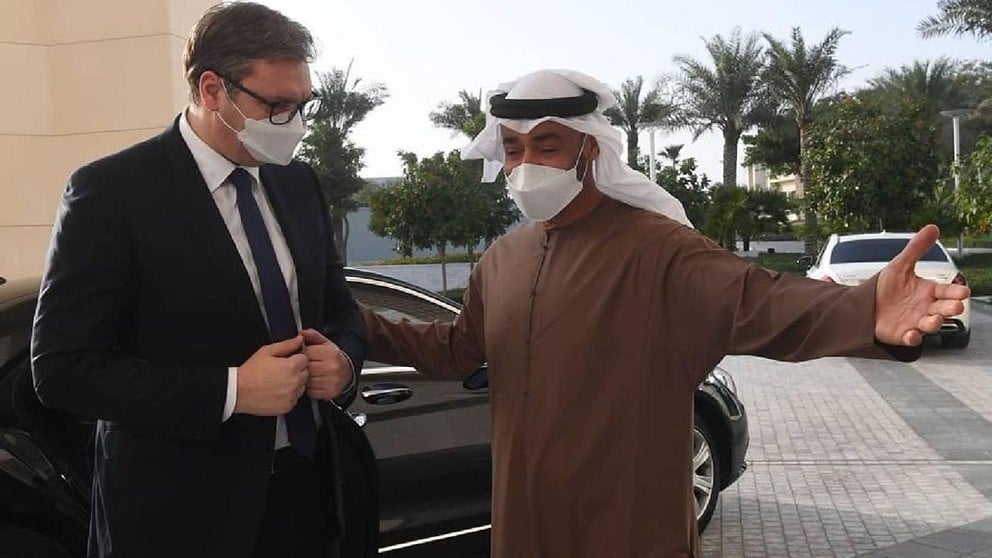 Foto: FoNet/ Instagram predsednika Srbije
Foto: FoNet/ Instagram predsednika SrbijeGodinu dana nakon promene vlasti na izborima 2012. godine, srpske javne finansije nalazile su se u velikim problemima.
For English version, please scroll down
Javni dug je bio na oštroj uzlaznoj putanji i na kraju 2013. iznosio 56 odsto BDP-a i to sa ogromnim kamatama, što je pak manje nego ove godine i u relativnom, a i za skoro 8,5 milijardi evra manje u nominalnom iznosu, iako sada imamo stabilne javne finansije. Svet se izvlačio iz svetske finansijske krize, ali ne i Srbija.
Prethodna, 2012. godina, bila je recesiona, a u 2013. je zabeležen oporavak, doduše skroman. Deficit budžeta 2012. godine iznosio je ogromnih 6,4 odsto, a 2013. nešto manje, ali i dalje visokih 5,1 odsto (visoki deficiti nastaviće se i naredne godine kada će zbog poplava biti zabeležena još jedna recesiona godina).
Potrebe za novcem u budžetu bile su velike, posebno, jer je tokom 2013. značajno pala naplata PDV-a, najznačajnijeg poreskog prihoda za budžet.
Naime, uprkos povećanju stope PDV-a krajem 2012. godine i povećanja BDP-a u 2013. (ukupno za šest odsto) naplata PDV-a je smanjena za četiri procenta. Tek 2017. godine efikasnost naplate PDV-a vratila se na nivo iz 2012. godine.
U februaru 2013. godine zaključen je Sporazum o saradnji između Vlade Republike Srbije i Vlade Ujedinjenih Arapskih Emirata.
U takvim okolnostima, tadašnji prvi potpredsednik Vlade Aleksandar Vučić došao je na spasonosnu ideju: da se zaduži kod Ujedinjenih Arapskih Emirata za tri milijarde evra. Bila je to „dolarska pozajmica šeika Muhameda Bin Zajeda po najpovoljnijim uslovima koje je naša zemlja ikada dobila“.
Kako su prenele agencije, prvi potpredsednik je „nedavno u Škotskoj zamolio šeika Muhameda Bin Zajeda da Ujedinjeni Arapski Emirati Srbiji daju dve ili tri milijarde dolara po najnižoj kamatnoj stopi, na 20 ili 30 godina. To bi bio gotovo poklon za ovu zemlju. Mi bismo delom tog novca vratili najteže kredite koji nas opterećuju.
Istovremeno bismo rasteretili nivo javnog duga, što mislim da bi MMF podržao, a ostatak novca bismo na različite načine ubrizgali u privredu. Posle toga će biti jasno da je Srbija opstala i krenula napred“, rekao je Vučić tih dana za RTS.
To je po svemu sudeći bila ulaznica za arapski kapital u Srbiju, u projektima koji su se po pravilu odvijali bez tendera i bez transparentnosti, kao što je zajedničko ulaganje u Er Srbiju, gradnja Beograda na vodi, kupovina poljoprivrednog zemljišta u Vojvodini. Među tim projektima su i privatni projekti šeika.
– Prvi potpredsednik je rekao da je uveren da će naš veliki prijatelj to učiniti za našu zemlju, i da on ovde želi profit, napominjući da će šeik graditi hotel na Kopaoniku, prenele su agencije: „Ja znam koliko su oni posvećeni prijatelji i da to ima veze da njihovim ličnim odnosom, što je mnogo drugačije nego kod nas ili na Zapadu. A naše je da ne bacimo to u bunar“, poručio je Vučić.
Za prvih milijardu dolara kod arapskog šeika zadužili smo se već sledeće godine na osnovu zakona donetog 6. marta 2014. godine. U saradnji Srbije sa UAE ne treba zaboraviti ulogu Mlađana Dinkića, tadašnjeg zamenika predsednika Komiteta Vlade za saradnju sa Ujedinjenim Arapskim Emiratima. On je najavio da će deo tih sredstava biti namenjen za otplatu dugova, pre svega MMF-u, a ostatak će biti investiran u poljoprivredu i druge vidove proizvodnje.
Predstavnici delegacije Srbije, predvođeni tadašnjim ministrom finansija Lazarom Krstićem, 29. i 30. januara 2014. godine na pregovorima sa predstavnicima Vlade Emirata Abu Dabi okvirno su dogovorili finansijske uslove zajma. Ti uslovi bili su da će Vlada Srbije pozajmiti milijardu dolara na period od 10 godina i on će dospeti u celosti nakon isteka 10 godina od datuma povlačenja sredstava, što znači da nas za tri godine očekuje isplata milijardu dolara iz budžeta.
Ugovorena je fiksna kamatna stopa od dva odsto i ona se imala plaćati polugodišnje, što je rata od po 10 miliona dolara na svakih šest meseci. Zatezna kamatna stopa u slučaju kašnjenja sa otplatom iznosila je tri odsto.
U tom trenutku to je zaista bio povoljan kredit. Naime, tokom 2014. godine država je u tri navrata emitovala desetogodišnje obveznice u evrima u ukupnom iznosu nešto ispod 125 miliona evra. Godišnji kupon (kamata koja se ima isplatiti kupcu obveznice) iznosila je pet odsto, a stopa prinosa 5,5 odsto (ovo znači da je za svaku obveznicu nominalne vrednosti 1.000 evra kupac platio oko 948 evra).
Prethodne, 2013. godine država je emitovala sedmogodišnje dolarske obveznice na koje je plaćala kamatu od 4,875 odsto godišnje, dok je za petogodišnje dolarske obveznice plaćala kamatu od 5,875 odsto.
Dakle kredit UAE zaista i jeste u tom trenutku bio najjeftiniji koji je Srbija mogla dobiti.
Nedugo zatim, u maju 2014. godine Skupština je usvojila zakon kojim se zadužila kod Fonda za razvoj Abu Dabija za još oko 100 miliona evra za prvu fazu razvoja sistema za navodnjavanje. Ovaj zajam je denominovan u dirhamima i vredeo je 356.281.000 dirhama ili 97 miliona dolara.
Namena ovih sredstava bila je da se naprave sistemi za navodnjavanje na 13 poljoprivrednih dobara u Vojvodini na površini od 24.000 hektara. Rok za otplatu ovog kredita je 15 godina, sa počekom od pet godina. Godišnja kamatna stopa iznosila je 2,5 odsto, a plaćala se i provizija za administriranje zajma od 0,5 odsto godišnje na povučeni iznos zajma.
Međutim, pošto projekti nisu bili gotovi, tek u julu 2017. godine arapski fond je zaista odobrio novac.
Ovo nije kraj zaduživanja Srbije kod arapskih partnera, jer početni dogovor, kako se može videti iz izjava Aleksandra Vučića, bio je da se pozajmi tri milijarde dolara.
Dakle, 2016. godine došlo je vreme da se uzme još jedna milijarda. Ovog puta, uslovi pod kojima je kredit dobijen nisu bili toliko povoljniji od tržišnih, ali se, ovog puta premijer Vučić potrudio da ućutka disonantne glasove.
„Mnogi nisu razumeli, čak ni neki potpredsednici vlade ni novinari. Ako neko nešto ne zna, bolje da pita, a ne da se pravi mnogo pametan i mudar. Nažalost, bolje je bilo da novinari ne pitaju pojedine članove Vlade, jer me oni očigledno nisu slušali na Vladi, ni u medijima, kad sam o tome govorio“, rekao je Vučić dodajući da je kredit uzet po najpovoljnijim mogućim uslovima.
„Samo nepismeni ljudi kritikuju, jer ne razumeju“, poručio je Vučić.
Ugovor o ovom kreditu potpisan je 4. oktobra 2016. godine, a u ime Vlade ga je potpisao ministar inostranih poslova Ivica Dačić. Tim ugovorom je predviđeno da Vlada Srbije od Fonda za razvoj Abu Dabija uzme pozajmicu u vrednosti 3.367.000.000 UAE dirhama što je iznosilo oko milijardu dolara i da je povlači u pet rata u vrednosti do približno 200 miliona dolara, u razmacima od najmanje šest meseci.
Kamatna stopa na ovaj kredit iznosila je 2,25 odsto godišnje na 10 godina sa grejs periodom od pet godina. Kod ovog zajma zanimljivo je što je ugovorena arbitraža, ne kod suda u Londonu kao kod prvog zajma. Naime, u slučaju spora navodi se da se osniva arbitražno telo koje čine po jedan član izabran od svake strane koji onda zajedno biraju trećeg. Ukoliko se ne dogovore, trećeg sudiju arbitražne komisije bira generalni sekretar Arapske lige.
Upravo sad u oktobru je isplaćena prva rata ovog kredita, a poslednja će biti isplaćena u aprilu 2026. godine.
U zakonu kojim je regulisano uzimanje ovog kredita navodi se da je cilj zajma podrška privrednom razvoju Republike Srbije putem smanjivanja troškova finansiranja, unapređenja ekonomske situacije u zemlji i doprinosa ostvarivanju planiranog razvoja.
Te 2016. godine zaduživanje Srbije je bilo i dalje skupo. U julu je država emitovala sedmogodišnje obveznice u dinarima i prodala ih po kuponu od 5,75 odsto.
Desetogodišnje obveznice u evrima emitovane u maju te godine nosile su kamatnu stopu od 3,5 odsto i kupon od 4,2 odsto.
Treću milijardu dolara Srbija do sada nije pozajmila. Od Ministarstva finansija nismo dobili odgovor koliko ukupno Republika Srbija duguje Emiratima, niti na šta su ta sredstva potrošena.
Sadržaj je rezultat istraživanja sprovedenog u okviru projekta „Transparentnost učešća države u stranim investicionim projektima“. Stavovi izneti u tekstu su stavovi autora i ne izražavaju nužno stavove donatora.
ENGLISH VERSION
The Arab Affair: It All Started with a Billion Dollar Loan
A year after the change of government in the 2012 elections, Serbian public finances were in big trouble. The national public debt was on a sharp upward trajectory and amounted to 56 percent of GDP at the end of 2013. Compared with this year, even though we now have stable public finances, the 2013 national public debt was smaller in relative terms – and almost 8.5 billion euros less in nominal terms, with very high interest rates.
In 2013, the world was recovering from the global financial crisis, but this was not the case for Serbia. After the recession in the previous year, only a modest recovery was recorded in 2013. The budget deficit in 2012 amounted to a huge 6.4 percent, and, while it decreased in 2013, it was still high 5.1 percent (high deficits will continue the following year, when another recession year will be recorded due to the floods).
The needs for money in the budget were great, due to the 2013 significant decrease in the collection of VAT, the most important tax revenue for the budget. Namely, despite the increase in the VAT rate at the end of 2012 and the increase in GDP in 2013 (by a total of six percent), the collection of VAT dropped by four percent. Only in 2017, the efficiency of VAT collection returned to the level from 2012.
In February 2013, the Agreement on Cooperation between the Government of the Republic of Serbia and the Government of the United Arab Emirates was signed.
Under such circumstances, the then Principal Deputy Prime Minister Aleksandar Vučić came up with a bailout idea – to borrow three billion euros from the United Arab Emirates.
It was „a dollar loan from Sheikh Mohammed Bin Zayed under the most favorable terms that our country has ever received.“
As the news agencies reported, the Principal Deputy Prime Minister of Serbia, Aleksandar Vučić, „recently asked Sheikh Mohammed Bin Zayed in Scotland if the United Arab Emirates would give Serbia two or three billion dollar loan at the lowest interest rate, for 20 or 30 years“.
This loan would almost be a gift for this country. We would use a part of that money to pay back the largest loans that burden us. At the same time, we would relieve the level of public debt, which I think the IMF would support, and we would inject the rest of the money into the economy in various ways. „After that, it will be clear that Serbia has survived and moved forward,“ Vučić told RTS.
Apparently, it was a ticket for the Arab capital to Serbia, in projects that, as a rule, took place without tenders and without transparency, such as the joint investment in Air Serbia, the Belgrade Waterfront development project, acquisition of agricultural land in Vojvodina, etc.. The sheikh’s private investments are part of these projects, too.
The news agencies reported that the Principal Deputy Prime Minister said that he was convinced that our great friend, the sheikh, would do it for our country, and that he also wanted to make a profit here and would build a hotel on Kopaonik. „I know how dedicated friends they are and that it has to do with their personal relationship, which is much different than in our country or in the west. And we should not to waste the opportunities this personal relationship brings to us“, Vučić said.
We borrowed the first billion dollars from the Arab sheikh the following year, based on the law that was passed on March 6, 2014. In the cooperation between Serbia and the UAE, we should not forget the role of Mladjan Dinkic, the then Deputy Chairman of the Government Committee for Cooperation with the United Arab Emirates. He announced that part of these funds would be used to service the debt, primarily to the IMF, and the rest will be invested in agriculture and other types of production.
Representatives of the Serbian delegation, led by the then Minister of Finance Lazar Krstić, roughly agreed on the financial terms of the loan on January 29 and 30, 2014 in Abu Dhabi, during negotiations with representatives of the Government of the Emirate of Abu Dhabi.
The conditions provided that the Government of Serbia would borrow one billion dollars for a period of 10 years, and it would be due in full after the expiration of 10 years from the date of withdrawal, which means that we are expected to pay one billion dollars from the budget in three years. A fixed interest rate of two percent was agreed and it had to be paid semi-annually, which is a installment of 10 million dollars every six months. The default interest rate in case of delay in repayment was three percent.
At the time, it was indeed a good loan. Namely, during 2014, the state issued ten-year bonds in euros on three occasions in the total amount of just under 125 million euros. The annual coupon (interest to be paid to the buyer of the bond) was five percent, and the yield rate was 5.5 percent (this means that for each bond with a nominal value of 1,000 euros, the buyer paid about 948 euros). Previously, in 2013, the state issued seven-year dollar bonds with the interest rate of 4.875 percent per year, while for five-year dollar bonds it paid the interest rate of 5.875 percent.
So the UAE loan was indeed the cheapest that Serbia could get at that time.
Shortly afterwards, in May 2014, the Serbian Assembly passed a law on borrowing another 100 million euros from the Abu Dhabi Development Development Fund for the first phase of the irrigation system development project. This loan was denominated in dirhams and was worth 356,281,000 dirhams or $ 97 million.
The purpose of these funds was to make irrigation systems for 13 agricultural properties in Vojvodina in an area of 24,000 hectares. The repayment period of this loan is 15 years, with a grace period of five years. The annual interest rate was 2.5 percent, and a loan administration fee of 0.5 percent per year was paid on the withdrawn loan amount.
However, since the project documentation was not finished, it was only in July 2017 that the Arab Fund really approved the money.
This was not the end of Serbia’s borrowing from Arab partners, because the initial agreement, as can be seen from Aleksandar Vučić’s statements, was to borrow three billion euros.
So, in 2016, it was time to take another billion. This time, the conditions under which the loan was obtained were not so much more favorable than the market ones, but this time, Prime Minister Vučić tried to silence the dissonant voices.
„Many did not understand it, not even some deputy prime ministers or journalists. If someone doesn’t know something, it is better to ask, and not to pretend to be very smart and wise. Unfortunately, it is better for journalists not to ask certain members of the government, because they obviously did not listen to me in the government, or in the media, when I talked about it,“ Vučić said, adding that the loan was taken under the most favorable terms possible.
„Only illiterate people criticize, because they do not understand,“ Vučić said.
The agreement on this loan was signed on October 4, 2016, and it was the then Minister of Foreign Affairs, Ivica Dačić, who signed it on behalf of the Government. The agreement provides that the Government of Serbia will take a loan of 3,367,000,000 UAE dirhams from the Abu Dhabi Development Fund, which amounted to about a billion dollars, and that it will withdraw it in five installments worth approximately 200 million dollars each, at intervals of at least six months.
The interest rate on this loan was 2.25 percent per annum for 10 years with a grace period of five years. It is interesting with this loan that arbitration has been agreed, not with the court in London as it was the case with the first loan. Namely, in the case of a dispute, it is stated that an arbitration body shall be established, consisting of one member elected by each party, who shall then jointly elect a third member of the arbitration body. If they do not agree, the third judge of the Arbitration Commission shall be elected by the Secretary General of the Arab League.
The first installment of this loan has just been paid in October 2021, and the last one will be paid in April 2026.
The law regulating the raising of this loan states that the goal of the loan is to support the economic development of the Republic of Serbia by reducing financing costs, improving the economic situation in the country and contributing to the planned development.
In 2016, Serbia’s borrowing was still expensive. In July, the state issued seven-year bonds in dinars and sold them on a 5.75 percent coupon rate.
Ten-year euro bonds issued in May of that year carried an interest rate of 3.5 percent and a coupon of 4.2 percent.
The content is the result of the research carried out within the project „Transparency of State Participation in Foreign Investment Projects“. The views expressed in the text are those of the authors and do not necessarily reflect the views of the donor.
Pratite nas na našoj Facebook i Instagram stranici, ali i na Twitter nalogu. Pretplatite se na PDF izdanje lista Danas.

